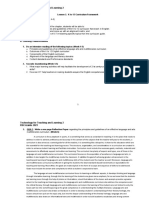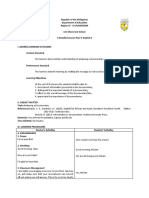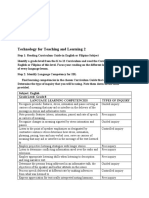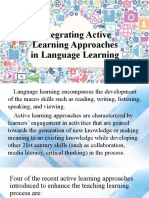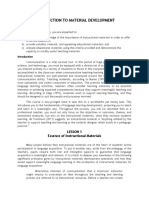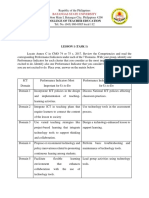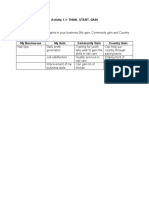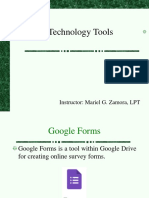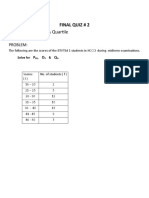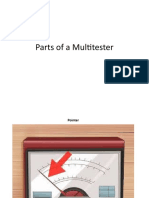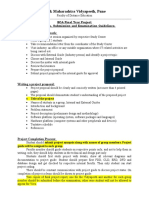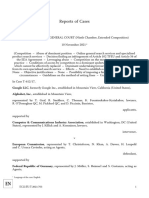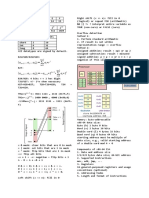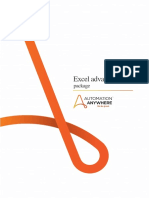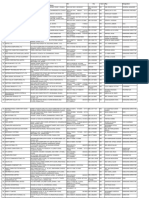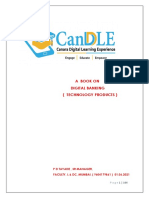Productivity Software Applications
Productivity Software Applications
Uploaded by
Angel MoralesCopyright:
Available Formats
Productivity Software Applications
Productivity Software Applications
Uploaded by
Angel MoralesCopyright
Available Formats
Share this document
Did you find this document useful?
Is this content inappropriate?
Copyright:
Available Formats
Productivity Software Applications
Productivity Software Applications
Uploaded by
Angel MoralesCopyright:
Available Formats
Productivity Software Applications/Tools
for Teaching and Learning
Software for Educators and Students
Productivity software has the potential to significantly minimize the amount of
time teachers spend on repetitive and tedious tasks. Furthermore, productivity software
can be integrated into the curriculum and impact the learning of all students. There are
many different types of software, and equally as many uses. Remember, it is the effective
integration of quality software that makes a difference in teacher effectiveness and
student learning. In order to make wise choices about software implementation, it is
helpful to understand the range of software options available to schools today. Further,
to remain skillful technology-using educators, it behooves us to understand the
processes that software is "automating" for us and to practice strategies for staying
current with new software tasks.
Software
Software n. Date: 1960: something used or associated with and usually
contrasted with hardware as: a: the entire set of programs, procedures, and related
documentation associated with a system and especially a computer system; specifically:
computer programs b: materials for use with audiovisual equipment Source: Merriam-
Webster Online (Links to an external site.)
Software 2012: "The instructions telling a computer what to do and how to do
it.... The term was coined to contrast to the old term hardware (meaning physical
devices)."
Software applications have become the paints and pencils of many of today's
students. They are also the graph paper, sheet music, canvas, and notebook. Many of
today's students are more comfortable drawing with a mouse than drawing with a pencil.
Some prefer to type over handwriting a letter or paper. Many people actually think better
at a keyboard than when staring at a blank piece of paper. All types of software
applications are being utilized to improve and enhance everyday activities including
learning activities.
Software applications also have made a dramatic difference in the lives of
students with special needs. Students learn best when they are able to use their
dominant learning style. Multimedia and digital media software applications appeal to
more than one learning modality and can therefore improve a student's chance for
success in mastering concepts. Whether a visual learner, auditory, or kinesthetic
learner, multimedia and digital software applications allow students to interact with
information in a manner most comfortable for them. By setting up learning activities
using these types of software applications, students can also visit and revisit the
activities as often as they need to reinforce the concepts.
Instructional Software for Classroom Use
Instructional software for classroom used to be easy to designate a software
package by the type of teaching function it served. It was a drill-and-practice, tutorial,
simulation, instructional game, or problem solving program. (See descriptions in Table
below) These terms originated because each package had clearly different
characteristics and served a different instructional purpose. In contrast, much of today’s
software defies easy classification because many software packages contain several
different activities, each of which may perform a different function. For example,
language-learning software may have a number of straight drill activities along with
activities that fulfil problem solving and game functions.
Table 1. Five Instructional Software Functions
Function/Examples Description
Allows learners to work problems or answer questions
Drill and Practice
and get feedback on correctness
Acts like a human tutor by providing all the information
Tutorial and instructional activities a learner needs to master a
topic: information summaries, explanation, practice
routines, feedback, and assessment.
Simulation Models real or Imaginary systems to show how those
systems or similar one’s work.
Increases motivation by adding game rules to drills or
Instructional Game
simulations
(a) Teachers directly (through explanation and/or
practice) the steps involved in solving
Problem Solving problems or
(b) helps learners acquire problem-solving skills by
giving them opportunities to
solve problems.
You might also like
- Novel Enny Arrow PDF 20 PDFDocument4 pagesNovel Enny Arrow PDF 20 PDFJink Black50% (10)
- Software For Educators and StudentsDocument12 pagesSoftware For Educators and StudentsJianne Mei VenturaNo ratings yet
- Tangible Product: Report in Educ 11 A (Assessment Learning 2) Performance-Based TaskDocument5 pagesTangible Product: Report in Educ 11 A (Assessment Learning 2) Performance-Based TaskRhylet GorospeNo ratings yet
- LESSON 1-Technology For Teaching and Learning 1 (TTL1Document31 pagesLESSON 1-Technology For Teaching and Learning 1 (TTL1Marites Ortega100% (1)
- AnswerDocument4 pagesAnswerBelle Herminigildo Angeles100% (1)
- Profed 4 - Technology in Teaching and Learning 1Document7 pagesProfed 4 - Technology in Teaching and Learning 1Suga MinNo ratings yet
- TTL - Lesson 2 (OBA 3 AND 4)Document5 pagesTTL - Lesson 2 (OBA 3 AND 4)TEPORA Johnhael JeoulsNo ratings yet
- Teaching and Assessment of The Macro SkillsDocument20 pagesTeaching and Assessment of The Macro SkillshesangartlezNo ratings yet
- Major 9: Language Programs and Policies in Multingual Society Indigenous Language ProgramDocument3 pagesMajor 9: Language Programs and Policies in Multingual Society Indigenous Language ProgramAngela Rose BanastasNo ratings yet
- Eng 124 - Unit 2 L 4-6Document20 pagesEng 124 - Unit 2 L 4-6Elrose Saballero KimNo ratings yet
- Prof Ed 8 M4 Topic 1Document8 pagesProf Ed 8 M4 Topic 1Winefredo Quiapo PaghubasanNo ratings yet
- Individual Activity 3:: I. EvaluationDocument4 pagesIndividual Activity 3:: I. EvaluationCarlin Charmy Vej AdonaNo ratings yet
- EL 107 Working ModuleDocument95 pagesEL 107 Working Modulecharlesbagtas8No ratings yet
- Lesson Plan For Teaching ReadingDocument13 pagesLesson Plan For Teaching ReadingHumaira RiazNo ratings yet
- EL 105 Learning Guide EspirituDocument18 pagesEL 105 Learning Guide EspirituDebong EspirituNo ratings yet
- Learning Activity 4Document1 pageLearning Activity 4Vanessa FilipinasNo ratings yet
- Google ClassroomDocument9 pagesGoogle Classroomji hoNo ratings yet
- Analyzing A Documentary Lesson PlanDocument13 pagesAnalyzing A Documentary Lesson PlanJennilyn BeringuelaNo ratings yet
- DLP Philippine LitDocument9 pagesDLP Philippine Litcristinematinez24No ratings yet
- TTL Written ReportDocument79 pagesTTL Written ReportSheilamae Bocabal CahiyangNo ratings yet
- Multicultural and Global Literacy PDFDocument4 pagesMulticultural and Global Literacy PDFJunna Treschia GUIMARY0% (2)
- Applications of Ict PoliciesDocument4 pagesApplications of Ict PoliciesGed RocamoraNo ratings yet
- Assignment No. 1: GENERAL INSTRUCTION: Use Microsoft Word, Legal, 12 Arial. COPY THE FORMATDocument2 pagesAssignment No. 1: GENERAL INSTRUCTION: Use Microsoft Word, Legal, 12 Arial. COPY THE FORMATLian AndrealsNo ratings yet
- MODULE 5. Developmental Reading Topic 5. Building Vocabulary SkillsDocument10 pagesMODULE 5. Developmental Reading Topic 5. Building Vocabulary SkillsBeverly Panganiban CadacioNo ratings yet
- Language Program Vs Language Framework-Group 1Document10 pagesLanguage Program Vs Language Framework-Group 1Charlene Mae CalongeNo ratings yet
- Traditional LiteracyDocument15 pagesTraditional LiteracyMark Kenneth Ceballos100% (1)
- ED123 - Unit 3 - Lesson 2 2Document16 pagesED123 - Unit 3 - Lesson 2 2Hezel Cabunilas100% (1)
- Case StudyDocument10 pagesCase StudycornejababylynneNo ratings yet
- Insturctional MaterialDocument4 pagesInsturctional Materialimie aldoyesaNo ratings yet
- Module 3 Lesson 1Document20 pagesModule 3 Lesson 1Angela Rose BanastasNo ratings yet
- Activity 7.1: Baoy, Mikee D. Bsed - Math 3Document5 pagesActivity 7.1: Baoy, Mikee D. Bsed - Math 3maxene jadeNo ratings yet
- Digital Literacy Skills-Finding, Using, Creating Information and Understanding Digital Practices Not Confident Somewhat Confident Very ConfidentDocument3 pagesDigital Literacy Skills-Finding, Using, Creating Information and Understanding Digital Practices Not Confident Somewhat Confident Very ConfidentJana Luz Dumam-ag PabalayNo ratings yet
- 2.4 Assessment For, of and As Learning (GROUP 7)Document10 pages2.4 Assessment For, of and As Learning (GROUP 7)Annielyn E AuditorNo ratings yet
- ED 201 - Technology For Teaching and Learning 1Document11 pagesED 201 - Technology For Teaching and Learning 1Ednylyn Joyce Capa100% (1)
- Name Module No: - 7 - Module Title: Learners With Difficulty Hearing Course and Section: BSED-3A - Major: Social ScienceDocument5 pagesName Module No: - 7 - Module Title: Learners With Difficulty Hearing Course and Section: BSED-3A - Major: Social ScienceChristine Joy Marcel100% (1)
- Reflection: "21 Century Literacy Skills and Teaching Resources"Document4 pagesReflection: "21 Century Literacy Skills and Teaching Resources"Berryl MayNo ratings yet
- Module 13 FaciDocument11 pagesModule 13 FaciElla Mae BalidoNo ratings yet
- Developing Core QuestionsDocument3 pagesDeveloping Core QuestionsLady Diane Manlisis (Lady)No ratings yet
- Module 7 Foundation of SPED - Docx 1Document10 pagesModule 7 Foundation of SPED - Docx 1Shervee PabalateNo ratings yet
- EL 105 Materials DevelopmentDocument3 pagesEL 105 Materials DevelopmentCosinas, Lairah Chen B.No ratings yet
- Teaching and Assessing Speaking 1Document9 pagesTeaching and Assessing Speaking 1dychavezramseyNo ratings yet
- The Teacher and The CommunityDocument9 pagesThe Teacher and The CommunityjaphethNo ratings yet
- Module 7 (AoL2)Document7 pagesModule 7 (AoL2)Cristobal CantorNo ratings yet
- Integrating Active Learning Approaches in Language Learning ReportDocument29 pagesIntegrating Active Learning Approaches in Language Learning ReportJessaMae AlbaracinNo ratings yet
- Written Task No.4Document2 pagesWritten Task No.4Cherry Lou De GuzmanNo ratings yet
- What Is Educational Technology?Document3 pagesWhat Is Educational Technology?jeralyn AmorantoNo ratings yet
- Reflection of Literature of The 21st Century WebinarDocument2 pagesReflection of Literature of The 21st Century WebinarNur SetsuNo ratings yet
- Materials For The Teaching of GrammarDocument26 pagesMaterials For The Teaching of GrammarNova Maria Fe GomezNo ratings yet
- The Prodigal SonDocument8 pagesThe Prodigal SonmarvielynmanuelNo ratings yet
- Introduction To Material Devt Pt. 1Document5 pagesIntroduction To Material Devt Pt. 1Renz E. FerreraNo ratings yet
- Espedido, Myansan T. (Edu 103)Document2 pagesEspedido, Myansan T. (Edu 103)Enrique EspedidoNo ratings yet
- Limbauan, Bello D. Final Detailed Lesson Plan.Document12 pagesLimbauan, Bello D. Final Detailed Lesson Plan.Bello LimbauanNo ratings yet
- The Impact of Technology-Enhanced Language Learning On English Proficiency: A Comparative Study of Digital Tools and Traditional MethodsDocument3 pagesThe Impact of Technology-Enhanced Language Learning On English Proficiency: A Comparative Study of Digital Tools and Traditional MethodsMamta AgarwalNo ratings yet
- Lesson 1 Task 1Document2 pagesLesson 1 Task 1Kyle Brian S. LumanglasNo ratings yet
- Cabellon CbarDocument21 pagesCabellon CbarAdi CabellonNo ratings yet
- University of Cebu - Main Campus College of Teacher Education Sanciangko Street, Cebu City SECOND SEMESTER 2021-2022 TC Ec 322 - Enhancement Course 2Document8 pagesUniversity of Cebu - Main Campus College of Teacher Education Sanciangko Street, Cebu City SECOND SEMESTER 2021-2022 TC Ec 322 - Enhancement Course 2Kazumi WelhemsenNo ratings yet
- PEDSC 311 - The Teacher and The School Curriculum: Course Developer: Jane Evita S. NgoDocument39 pagesPEDSC 311 - The Teacher and The School Curriculum: Course Developer: Jane Evita S. NgoLudioman MaricelNo ratings yet
- Learning Module 8 - Ecological LiteracyDocument9 pagesLearning Module 8 - Ecological LiteracyJan Marco PacasNo ratings yet
- Using Authentic Materials in The ClassroomDocument18 pagesUsing Authentic Materials in The Classroomannmarietunney100% (2)
- Session 5 Language Culture and SocietyDocument15 pagesSession 5 Language Culture and SocietyRHEA MARIMLA100% (2)
- Through the Looking-Glass, and What Alice Found There: Unabridged with the Original Illustrations by John TennielFrom EverandThrough the Looking-Glass, and What Alice Found There: Unabridged with the Original Illustrations by John TennielNo ratings yet
- Activity 1Document1 pageActivity 1Angel MoralesNo ratings yet
- Technology Tools: Instructor: Mariel G. Zamora, LPTDocument11 pagesTechnology Tools: Instructor: Mariel G. Zamora, LPTAngel MoralesNo ratings yet
- q2 - Math - Final - Rel. Pos.Document1 pageq2 - Math - Final - Rel. Pos.Angel MoralesNo ratings yet
- Characteristics of A Good Instructional MaterialsDocument2 pagesCharacteristics of A Good Instructional MaterialsAngel MoralesNo ratings yet
- Parts of A MultitesterDocument7 pagesParts of A MultitesterAngel MoralesNo ratings yet
- Computer Integrated Manufacturing : Lecturer: VU VAN PHONGDocument47 pagesComputer Integrated Manufacturing : Lecturer: VU VAN PHONGToy and MeNo ratings yet
- 2.5 ReleaseNoteDocument11 pages2.5 ReleaseNoteM D. M.No ratings yet
- Tilak Maharashtra Vidyapeeth, Pune: How To Begin A Project WorkDocument6 pagesTilak Maharashtra Vidyapeeth, Pune: How To Begin A Project WorkAdnan AnsariNo ratings yet
- 5 in 1 V2 ManualDocument16 pages5 in 1 V2 ManualGerman ParceroNo ratings yet
- Security Assignment II Report 1.1Document22 pagesSecurity Assignment II Report 1.1htethtetwint12.esNo ratings yet
- Celex 62017TJ0612 en TXTDocument143 pagesCelex 62017TJ0612 en TXTV BanerjeeNo ratings yet
- Shashank Soma: Profile SummaryDocument4 pagesShashank Soma: Profile SummaryShashankSomaNo ratings yet
- Record - Index PageDocument2 pagesRecord - Index Pageakshra TyagiNo ratings yet
- Caepipe: Tutorial For Modeling and Results Review Problem 2Document93 pagesCaepipe: Tutorial For Modeling and Results Review Problem 2FRANCISCONo ratings yet
- Python - Objective 08 Learn How To Use Arrays and Lists WorkbookDocument25 pagesPython - Objective 08 Learn How To Use Arrays and Lists WorkbookHana JuiceNo ratings yet
- Shell& Tube HT DesignDocument8 pagesShell& Tube HT Designvsraochemical1979100% (1)
- 5000 Series: Manual AC Power Source Operation Manual For Models 5005 5010 5020 5040Document45 pages5000 Series: Manual AC Power Source Operation Manual For Models 5005 5010 5020 5040Daniel AsquiNo ratings yet
- Vsens Sofware Design DocumentDocument25 pagesVsens Sofware Design DocumentkumarcscsNo ratings yet
- Concurrent Validity and Reliability of Sprinting Force Velocity Profile Assessed With GPS Devices in Elite AthletesDocument15 pagesConcurrent Validity and Reliability of Sprinting Force Velocity Profile Assessed With GPS Devices in Elite AthletesMiguel Villar NavarroNo ratings yet
- Unit 4, Lesson 2, Worksheet 12: The Blue Pants Costs Fifty Dollars and The Green Pants Cost Twenty DollarsDocument18 pagesUnit 4, Lesson 2, Worksheet 12: The Blue Pants Costs Fifty Dollars and The Green Pants Cost Twenty DollarsEdward Jeffrey Meza SantomeNo ratings yet
- Standard Cheat SheetDocument6 pagesStandard Cheat SheetJeremy JohnNo ratings yet
- Clean Code v2017 enDocument55 pagesClean Code v2017 encalabi mozartNo ratings yet
- WinCC TIA Archiving ServerNAS DOC v2.0 enDocument37 pagesWinCC TIA Archiving ServerNAS DOC v2.0 enRojbeni Mohamed MahdiNo ratings yet
- Get Distributed Systems 4th Edition Maarten Van Steen PDF ebook with Full Chapters NowDocument55 pagesGet Distributed Systems 4th Edition Maarten Van Steen PDF ebook with Full Chapters Nowtosamtepetl100% (1)
- IBM Systems Storage Toolbox V4Document44 pagesIBM Systems Storage Toolbox V4liew99100% (1)
- Jimma University Institute of Technology Cover PageDocument9 pagesJimma University Institute of Technology Cover PageAyub AliNo ratings yet
- Unit Ii HTML and XHTMLDocument81 pagesUnit Ii HTML and XHTMLSinthujaNo ratings yet
- Turing-Machine A4Document16 pagesTuring-Machine A4metodoiset2025No ratings yet
- Automating Tasks Using The Automation 360 Excel Advanced PackageDocument18 pagesAutomating Tasks Using The Automation 360 Excel Advanced PackageJeet TrivediNo ratings yet
- LiteVNA - User GuideDocument28 pagesLiteVNA - User GuideKikdiNo ratings yet
- List Member PIPALDocument38 pagesList Member PIPALFahad khandokerNo ratings yet
- CM3022 How To Set UpDocument4 pagesCM3022 How To Set UptasneemengsolNo ratings yet
- Digital BankingDocument106 pagesDigital BankingSandeepa ThirthahalliNo ratings yet
- Datasheet Speedy 100C 8063 en 1Document3 pagesDatasheet Speedy 100C 8063 en 1Laur BNo ratings yet






